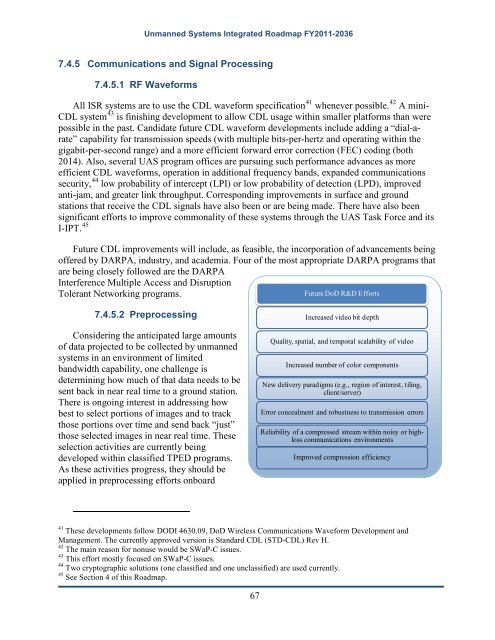Unmanned Systems Integrated Roadmap FY2011-2036 - Defense ...
Unmanned Systems Integrated Roadmap FY2011-2036 - Defense ...
Unmanned Systems Integrated Roadmap FY2011-2036 - Defense ...
You also want an ePaper? Increase the reach of your titles
YUMPU automatically turns print PDFs into web optimized ePapers that Google loves.
<strong>Unmanned</strong> <strong>Systems</strong> <strong>Integrated</strong> <strong>Roadmap</strong> <strong>FY2011</strong>-<strong>2036</strong><br />
7.4.5 Communications and Signal Processing<br />
7.4.5.1 RF Waveforms<br />
All ISR systems are to use the CDL waveform specification 41 whenever possible. 42 A mini-<br />
CDL system 43 is finishing development to allow CDL usage within smaller platforms than were<br />
possible in the past. Candidate future CDL waveform developments include adding a “dial-arate”<br />
capability for transmission speeds (with multiple bits-per-hertz and operating within the<br />
gigabit-per-second range) and a more efficient forward error correction (FEC) coding (both<br />
2014). Also, several UAS program offices are pursuing such performance advances as more<br />
efficient CDL waveforms, operation in additional frequency bands, expanded communications<br />
security, 44 low probability of intercept (LPI) or low probability of detection (LPD), improved<br />
anti-jam, and greater link throughput. Corresponding improvements in surface and ground<br />
stations that receive the CDL signals have also been or are being made. There have also been<br />
significant efforts to improve commonality of these systems through the UAS Task Force and its<br />
I-IPT. 45<br />
Future CDL improvements will include, as feasible, the incorporation of advancements being<br />
offered by DARPA, industry, and academia. Four of the most appropriate DARPA programs that<br />
are being closely followed are the DARPA<br />
Interference Multiple Access and Disruption<br />
Tolerant Networking programs.<br />
Future DoD R&D Efforts<br />
7.4.5.2 Preprocessing<br />
Considering the anticipated large amounts<br />
of data projected to be collected by unmanned<br />
systems in an environment of limited<br />
bandwidth capability, one challenge is<br />
determining how much of that data needs to be<br />
sent back in near real time to a ground station.<br />
There is ongoing interest in addressing how<br />
best to select portions of images and to track<br />
those portions over time and send back “just”<br />
those selected images in near real time. These<br />
selection activities are currently being<br />
developed within classified TPED programs.<br />
As these activities progress, they should be<br />
applied in preprocessing efforts onboard<br />
41<br />
These developments follow DODI 4630.09, DoD Wireless Communications Waveform Development and<br />
Management. The currently approved version is Standard CDL (STD-CDL) Rev H.<br />
42<br />
The main reason for nonuse would be SWaP-C issues.<br />
43<br />
This effort mostly focused on SWaP-C issues.<br />
44<br />
Two cryptographic solutions (one classified and one unclassified) are used currently.<br />
45<br />
See Section 4 of this <strong>Roadmap</strong>.<br />
67<br />
Increased video bit depth<br />
Quality, spatial, and temporal scalability of video<br />
Increased number of color components<br />
New delivery paradigms (e.g., region of interest, tiling,<br />
client/server)<br />
Error concealment and robustness to transmission errors<br />
Reliability of a compressed stream within noisy or highloss<br />
communications environments<br />
Improved compression efficiency

















